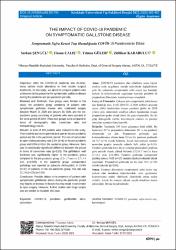| dc.contributor.author | Şengül, Serkan | |
| dc.contributor.author | Çalış, Hasan | |
| dc.contributor.author | Güler, Yılmaz | |
| dc.contributor.author | Karabulut, Zülfikar | |
| dc.date.accessioned | 2023-05-23T07:42:26Z | |
| dc.date.available | 2023-05-23T07:42:26Z | |
| dc.date.issued | 2021 | en_US |
| dc.identifier.uri | https://search.trdizin.gov.tr/tr/yayin/detay/507907/the-impact-of-covid-19-pandemicon-symptomatic-gallstone-disease | |
| dc.identifier.uri | https://hdl.handle.net/20.500.12868/2163 | |
| dc.description.abstract | Objective: After the COVID-19 pandemic was declared, many centers made alterations in their routine surgical treatments. In this study, we aimed to compare patients who underwent cholecystectomy for symptomatic gallstone disease during the pandemic and pre-pandemic periods.Material and Methods: Two groups were formed in this study; the pandemic group consisting of patients with symptomatic gallstone disease who underwent surgery between March 11 2020 and January 31 2020, and the pre-pandemic group consisting of patients who were operated in the same period of 2019. These two groups were compared in terms of demographic data, conversion rates and histopathology results.Results: A total of 293 patients were included in the study. Two hundred and seven patients took part in the pre-pandemic period and 86 in the pandemic period. The rate of conversion to open cholecystectomy was 2.8% (n=6) in the pre-pandemic group and 6.9% (n=6) in the pandemic group. However, there was no statistically significant difference between the groups in terms of conversion rates (p=0.10). The gallbladder wall thickness was significantly higher in the pandemic group compared to the pre-pandemic group (3.2±1.7 mm vs. 2.7±1.4 mm, p=0.009). In the pandemic group, postoperative pathology was reported as subacute cholecystitis in 19.8% (n=17) of patients. In the pre-pandemic group, this rate was 11.1% (n=23) (p=0.04).Conclusion: Possible delays in the treatment of patients with symptomatic gallbladder stones during the pandemic period may lead to an increase in factors that may result in conversion to open surgery. However, further studies with large sample size are needed to elucidate this issue. | en_US |
| dc.language.iso | eng | en_US |
| dc.relation.isversionof | 10.24938/kutfd.904795 | en_US |
| dc.rights | info:eu-repo/semantics/openAccess | en_US |
| dc.subject | COVID-19 | en_US |
| dc.subject | Pandemic | en_US |
| dc.subject | Gallbladder Stone | en_US |
| dc.subject | Conversion | en_US |
| dc.subject | Pandemi | en_US |
| dc.subject | Safra Kesesi Taşı | en_US |
| dc.subject | Konversiyon | en_US |
| dc.title | The Impact of Covid-19 Pandemicon Symptomatic Gallstone Disease | en_US |
| dc.type | article | en_US |
| dc.contributor.department | ALKÜ, Fakülteler, Tıp Fakültesi, Cerrahi Tıp Bilimleri Bölümü | en_US |
| dc.identifier.volume | 23 | en_US |
| dc.identifier.issue | 3 | en_US |
| dc.identifier.startpage | 462 | en_US |
| dc.identifier.endpage | 467 | en_US |
| dc.relation.journal | Kırıkkale Üniversitesi Tıp Fakültesi Dergisi (Fen) | en_US |
| dc.relation.publicationcategory | Makale - Uluslararası Hakemli Dergi - Kurum Öğretim Elemanı | en_US |


















